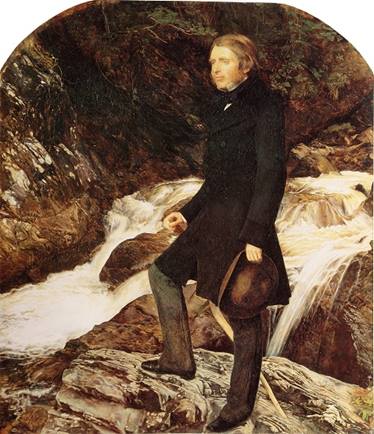Morgan, N., Polymath extraodinaire. Geoscientist 30 (4), 24, 2020
https://doi.org/doi: 10.1144/geosci2020-083, Download the pdf here
Geologist and science writer Nina Morgan explores the lesser known side of John Ruskin
 John Ruskin [1819 – 1900] is best known as an artist, critic, philanthropist and social reformer. But his first love was geology. As a child Ruskin’s geological interests were awakened by the Scottish landscape. Early on, though, it was mineralogy that really captured his imagination. As he recalled in his book Deucalion, a collection of his geological writings published in 1875:
John Ruskin [1819 – 1900] is best known as an artist, critic, philanthropist and social reformer. But his first love was geology. As a child Ruskin’s geological interests were awakened by the Scottish landscape. Early on, though, it was mineralogy that really captured his imagination. As he recalled in his book Deucalion, a collection of his geological writings published in 1875:
"..indeed, I began when I was only twelve years old, a Mineralogical Dictionary' intended to supersede everything done by Werner and Mohs, (and written in a shorthand composed of
crystallographic signs now entirely unintelligible to me)."
By the age of 15 Ruskin had already begun publishing geological essays in London’s Magazine of Natural History. Although he went up to Christ Church College, Oxford in 1837 to study classics, a month after his arrival Ruskin enrolled in William Buckland's [1784 – 1856] lectures on mineralogy. In spite of the fact that each series of lectures cost his father an additional fee of up to two guineas, he attended all of Buckland's lectures on mineralogy and geology throughout his student years, and produced drawings for many of them. In a letter to Buckland dated 4 November 1837, Ruskin's father thanked Buckland for the 'attentions you have so kindly bestowed on him [Ruskin] and offered 'my best thanks for these attentions to my Son'.
Joining the Geological Society
In 1840 Ruskin was elected a Fellow of the Geological Society, and remained a Fellow for the rest of his life. Interestingly, although by the late 1850s Ruskin had become very interested in social reform he doesn't appear to have ever joined the Geologists' Association. This organisation, established in 1858 and open to all 'to enable the practical student in Geology to find a congenial place where doubts may be stated and experience exchanged' might have seemed to be a natural home for someone interested in promoting the education of 'the workmen and labourers of Great Britain'.
Writing in QJGS his obituarist noted that:
"His career and his great services to art and to literature have been recorded in many publications; but we must not forget his services to our science, in directing the attention of artists and others to the effect of geological structure and of the characters of rocks on scenery. This is especially exemplified in what is, perhaps, his greatest work, Modern Painters, and I would refer to four chapters of vol. i, entitled Truth of Earth (pp. 265-319), and to the magnificent fourth volume, devoted to Mountain Beauty, eleven chapters of which on the ' Materials of Mountains/ Sculpture of Mountains, and Resulting Forms (pp. 107-324) might be read with advantage by many geologists."
Failed ambition
In spite of his many achievements and influential writing on many subjects, later in life Ruskin expressed some regret for not having followed up his "natural disposition for these sciences [geology and botany] [that] would certainly long ago have made me a leading member of the British Association for the Advancement of Science". And although Ruskin revealed in Deucalion that throughout his life he endeavoured "to keep abreast with the rising tide of geological knowledge; sometimes even, I believe pushing my way into little creeks in advance of the general wave", his Geological Society obituary records that 'he contributed no paper to this Society'. History records that neither did Ruskin achieve what he described in Deucalion as: "the position which it was always the summit of my early ambition to attain, that of President of the Geological Society".
End notes:
Sources include reviews of the free exhibition at Two Temple Place, London, 26 Jan – 22 April 2019, celebrating the cultural and social heritage of the Victorian polymath John Ruskin (1819–1900). by Duncan Palmer available at https://shnh.org.uk/2019/03/a-geologists-view-of-john-ruskin-the-power-of-seeing/ and https://www.geolsoc.org.uk/Geoscientist/Books-Arts/Geoscientist-book-reviews-online/2019-Book-reviews-online/Ruskin-Exhibition; Louise Pullen, Ruskin on Rocks, Art, Mountains and Mineralogy Sheffield Galleries and Museums Trust, 2006; Van Akin Burd, Ruskin and His ‘Good Master,’ William Buckland, Victorian Literature and Culture 36, no. 2, 2008, pp. 299–315. Available to view at https://www.jstor.org/stable/40347189; G.S. Sweeting , The Geologists's Association, a History, Benham and Company, 1958. I thank Wendy Cawthorne for sending me the text of Ruskin's obituary published in QJGS 56, pp lx – lxi, 1900.
Author
Nina Morgan is a geologist and science writer based near Oxford. Her latest book, The Geology of Oxford Gravestones, is available via www.gravestonegeology.uk
[author] Nina Morgan is a geologist and science writer based near Oxford. Her latest book, The Geology of Oxford Gravestones, is available via www.gravestonegeology.uk